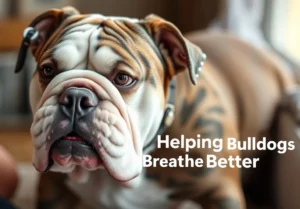As smushed faces and endless snorts steal our hearts, the whimsical charm of brachycephalic dogs comes with a breath of responsibility. Whether it’s your snuggle buddy struggling on a walk or the sleeping beauty sounding like a freight train at night, the punchline remains – breathing is no joke for these lovable breeds.
In this post, you’ll uncover the essentials of respiratory care for your flat-faced friend, keeping them happy, healthy, and, most importantly, breathing easy.
Key takeaways:
- Monitor for signs of BOAS like excessive panting and gagging; early detection can save your pet from distress.
- Help your brachycephalic dog stay cool and maintain a healthy weight to ease their breathing.
- Consult a vet experienced in brachycephalic breeds for tailored advice and consider surgery for severe cases.
Why Do Brachycephalic Breeds Struggle with Breathing?
Brachycephalic breeds, those adorable dogs with short noses and flat faces such as Bulldogs, Pugs, and French Bulldogs, have a unique anatomy that sets them apart. Their compact facial structure, while incredibly cute, is a double-edged sword. It’s this very feature that can lead to significant respiratory challenges. At the heart of these challenges is a condition known as Brachycephalic Obstructive Airway Syndrome (BOAS).
BOAS is a bit of a catch-all term referring to a range of issues these dogs can face, including narrowed nostrils, elongated soft palates, and potential laryngeal collapse. All of this narrows their airways, making it tougher for them to breathe even under the best of circumstances. Imagine trying to breathe through a straw; that’s a day in the life for these pups.
Recognizing the Signs: When Is It More Than Just a Snore?
Sure, the snuffles and snorts can seem endearing, but they can mask underlying issues. Knowing the difference between cute quirks and red flags is crucial. If your dog is struggling to catch their breath after a short walk, excessively panting, or showing signs of effort when breathing while resting, it’s time to perk up your ears. Gagging or retching, especially after meals or during excitement, isn’t just unpleasant—it could be a sign of BOAS.
Another symptom to keep an eye out for is blue-tinged gums, indicating that your pooch isn’t getting enough oxygen. If your furry friend exhibits any of these symptoms, especially if they’re sudden or severe, it’s paramount to seek veterinary attention. Early intervention can be a game-changer.
What Can You Do to Keep Air Flowing?
Living with a brachycephalic breed means being proactive about their respiratory care. Here are some tailor-made tips to keep your precious pooch breathing easy:
-
Keep Your Dog Cool : These breeds are more susceptible to overheating due to their breathing difficulties. Always provide shade and fresh water, and keep indoor spaces cool and well-ventilated. Avoid walking during peak heat—early mornings or late evenings are your best bets.
-
Manage their Weight : Extra pounds can exacerbate breathing problems, making it even harder for them to catch a breath. A balanced diet and regular, gentle exercise are key.
-
Smart Exercise : Speaking of exercise, understanding your dog’s limits is vital. Opt for several short, leisurely walks over lengthy, strenuous ones. And here’s a tip not everyone thinks about: using a harness instead of a collar can reduce the pressure on your dog’s throat and improve their comfort during walks.
-
Consider Environmental Allergens : Just like us, dogs can suffer from allergies that impair breathing. Regular cleaning to reduce dust, using hypoallergenic bedding, and avoiding smoking near your pet can all make a significant difference.
-
Tailor-made Tip : Invest in a small, portable fan for outings. This unique piece of advice isn’t something you’ll find on every pet blog out there, but it’s golden. A battery-operated fan can provide a quick way to cool down your brachycephalic breed if they start showing signs of overheating while you’re not at home. It’s a simple, effective solution to keep them comfortable, especially during the hot summer months.
Watching over a brachycephalic breed may require a bit more attention and care, but the joy and companionship these dogs provide are unparalleled. With the right precautions and a little extra love, your snub-nosed friend can lead a happy, healthy life. Stay tuned for more tips and insights on how to nurture your brachycephalic dog, because their well-being is worth every bit of effort.
The Role of Diet and Weight Management
When it comes to our brachycephalic furry friends, managing their diet and weight isn’t just about preventing a chubby belly; it’s crucial for their breathing. The structure of their short skulls means they’ve already got the odds stacked against them in the respiratory department, so every little bit of pressure we can take off their airways counts.
Why Weight Matters
Extra weight puts additional strain on the body, including the respiratory system. For brachycephalic breeds, whose airways are already compromised by their anatomy, being overweight can exacerbate problems like brachycephalic obstructive airway syndrome (BOAS). Essentially, fat deposits in the throat and neck can further narrow the already tight airways, making it harder for your pup to breathe.
Diet Dos and Don’ts
But it’s not just about the quantity of food – the quality matters too. Here are some tips to keep your pooch in tip-top shape:
- High-quality dog food: Opt for a diet that’s high in proteins and low in grains to avoid unnecessary fillers. This will help your dog feel fuller longer and keep those extra pounds at bay.
- Portion control: It might seem simple, but feeding the right amount is key. Stick to the feeding guidelines on the dog food package or consult with your vet to determine the ideal portion size based on your dog’s specific needs.
- Regular, gentle exercise: Just like for us, exercise is vital for weight management in dogs. However, for brachycephalic breeds, it’s crucial to avoid strenuous activity, especially in hot or humid weather, to prevent breathing difficulties.
The Unique Tip You Haven’t Heard
Most folks don’t think about hydration as part of weight management, but ensuring your brachy dog drinks plenty of water can actually help them maintain a healthy weight. Hydration aids in digestion and helps to keep them feeling full, potentially reducing overeating. Always make sure your dog has access to fresh water, especially after meals or exercise.
When to Consider Surgery?
Surgery can be a game changer for brachycephalic breeds suffering from severe breathing issues. It’s not a decision to take lightly, but for some dogs, it can significantly improve their quality of life.
Surgical Options
There are a few surgical procedures designed to open up those tight airways:
- Stenotic Nares Correction: This surgery widens the nostrils, allowing for easier breathing.
- Elongated Soft Palate Resection: Many brachycephalic dogs have an overly long soft palate that blocks their airways; this procedure trims it back.
- Laryngeal Saccules Removal: In advanced cases, the airway obstruction can lead to everted laryngeal saccules, which this surgery addresses.
Making the Decision
Deciding if surgery is right for your dog involves a detailed discussion with your vet, but here are some points to consider:
- Severity of symptoms: If your dog is struggling to breathe after minimal exertion, or shows signs of sleep apnea, it might be time to consider surgery.
- Quality of life: Are breathing issues preventing your dog from enjoying everyday activities?
- Age and overall health: Younger, healthier dogs typically recover from surgery more easily.
What to Expect
Preparation and recovery are just as important as the surgery itself. Your dog will need a thorough veterinary examination and possibly some tests to determine their suitability for surgery. Post-surgery, they’ll need a calm, comfortable place to recover and lots of TLC. Your vet might also recommend a weight management plan to support their breathing in the long run.
A Key Insight : Something often overlooked is the importance of choosing a vet with specific experience in brachycephalic surgery. These surgeries are delicate, and success rates can significantly increase when performed by a specialist knowledgeable about the unique challenges of brachycephalic breeds.
In conclusion, managing the diet and weight of your brachycephalic dog can significantly impact their respiratory health, and surgery, while a more drastic option, can dramatically improve the quality of life for dogs with severe breathing difficulties. Armed with the right knowledge and support from your vet, you can make the best decisions for your beloved pet’s health and happiness.
Alex, a passionate animal lover, has experience in training and understanding animal behavior. As a proud pet parent to two dogs and three cats, he founded AnimalReport.net to share insights from animal experts and expand his knowledge of the animal kingdom.





